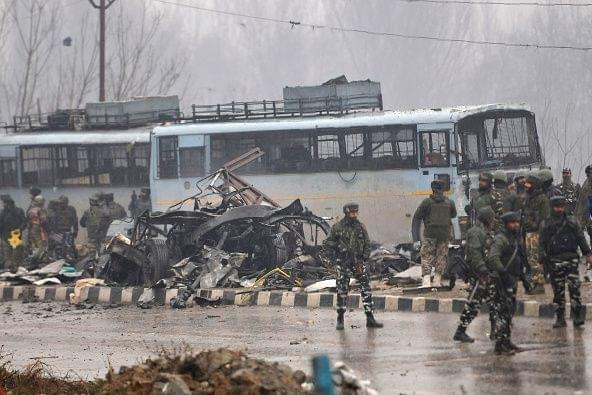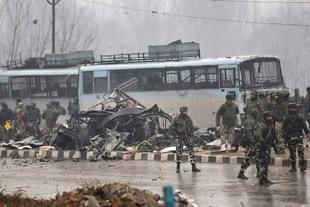Defence
Revisiting Pulwama: Can A Near Similar Incident Be In The Offing?
Syed Ata Hasnain
Mar 15, 2019, 04:12 PM | Updated 04:12 PM IST
Save & read from anywhere!
Bookmark stories for easy access on any device or the Swarajya app.


The car bomb attack at Pulwama perpetrated by the Jaish-e-Muhammad (JeM) with the sponsorship of Pakistan’s Inter-Services Intelligence (ISI) was enough to trigger such an escalatory spiral between India and Pakistan that the event itself lost focus in the chain of activities in its aftermath.
While the National Investigation Agency (NIA) undertook investigation almost immediately, the public attention was on the tragic impact which left more than 40 families all over India and the Indian public grieving for the unfortunate Central Reserve Police Force (CRPF) jawans. The response of the government came quicker than expected and focused attention on the target of the air strikes — Balakot, the post-strike damage assessment (PSDA) and international reaction to India’s actions. Expectedly, among all this the tragic incident itself was forgotten. Questions on whether it could have been avoided have been raised. There are also questions on whether it was an intelligence failure and whether it can be repeated anytime soon. But this has been a secondary point of focus.
Did I expect an incident like Pulwama? I would confess that I expected a ‘spectacular act’ being perpetrated anytime in 2018-19 and knowing the ISI’s penchant for innovation always perceived it would be a surprise.
The only thing is one could not estimate just how big an event would possibly occur. That an explosive device of high intensity was in the offing was not guess work but the deduction from a serious analysis which revealed that improvised explosive devises (IED) had dried up after July 2008 when an army bus was blown up by a sideways IED resulting in nine fatalities. It also revealed that the last car bomb attack was in 2004 when a gas cylinder filled with explosives and secured inside a Maruti 800, had rammed into an officer bus of the Naugam convoy at Pattan.
In the interim, the IED in the form of car bombs and suicide bombers strapped with explosives emerged in four internal conflicts — Iraq, Syria, Afghanistan and Pakistan. The potency of the weapon was well understood by the Pakistani deep state and I did assess that it was a matter of time before which car bombs and suicide bombers were reintroduced in the Kashmir Valley.
The fact that Operation All Out (the Indian security forces (SF) operation to weed out the 350 odd terrorists of both local and Pakistani linkage) had succeeded in achieving a level of domination was an important input in the matrix of responses expected from the deep state inside Pakistan. There is no doubt that even as Operation All Out was succeeding in curtailing numbers, there was a parallel effort towards recreating the same through local recruitment in south Kashmir and infiltration into north Kashmir. That domination was also not affording the conduct of a major act by the deep state supported terror entities.
From Pakistan’s perspective, such acts are necessary at regular intervals to keep the security and psychological space within control of the separatists and terrorist entities. The entry of radicalisation and rising alienation especially among the youth in Kashmir, provided anti-national elements the scope for planning and executing such an act. The return of explosives as a suitable weapon carried the additional advantage of being below the intelligence radar. It was not a generally accepted modus operandi having been out of existence in Kashmir’s security landscape for over a decade. That brought in the surprise element, which in the context of terror and anti-terror operations, carries tremendous value.
The common question being asked by many is whether Pulwama was an intelligence failure. It is expected and even fashionable to label spectacular negative acts by terrorists as intelligence failures of the state. That is because public expectation about intelligence is that hundred per cent of potential negative activities must be within their scanner. That rationale would actually make intelligence agencies nothing less than the god.
The aim of intelligence is to maximise pickups and in a timely manner to be able to piece together the jigsaw to ensure counter action to neutralise any such act in the offing. The term ‘maximise’, does not allude to hundred per cent which is never ever possible. India should thank its intelligence agencies for the numerous neutralisations they have achieved especially since 2008, which has kept India safe. It is usually extremely difficult to convert a vague unconfirmed input into actionable intelligence, unless a trend has emerged and a focus has been brought to bear.
Was the CRPF wrong in running a long convoy packed with soft skinned buses along the new National Highway alignment? Now here is a point of introspection. In 2004, the car bomb against an army bus failed to have the desired impact because the bus had been hardened by improvisation. It led to hardening of all army buses, at least those running on the Jammu-Srinagar route.
Should not security force coordination and cooperation provide the inputs to harden all buses for all forces involved in Kashmir, thus securing our jawans? People may find occasion here to score brownie points for political vilification. But, this is not a political failure but a systems failure where perception about inter-force cooperation extends to operations and intelligence, but not to existential issues of administration.
The weakest element of security in all counter terror operations in the country is road security. It is the domain of operations which is most predictable, extremely difficult and carries maximum threat to life of jawans. In this case, the absence of IEDs for a decade had obviously shifted focus to potential hit and run or ambush style strikes witnessed in Bijbehara and Pampore in 2017. It is easy to say that all civilian vehicles must be stopped when security convoys ply.
However, the reality is that a halted civilian vehicle must then have the scope to be moved laterally into by lanes away from the road alignment. Is that even possible though? Along a greenfield broad new alignment on which this CRPF convoy was moving, no such side roads existed to do that. As to the practicality of stopping all civilian traffic to give unimpeded way to 10 odd other convoys, the limited number of arteries present would paralyse all traffic. It’s a measure that can at best be temporary and sooner than later will need to be diluted.
The answer lies in focused intelligence through more and widespread deployment of human intelligence resources and technology. There is a need for use of rewards and money for information, besides the return to the zimmewari system. That was the good old way of making village and town communities vigilant about the potential planting of IEDs or fabrication of car bombs. Use of drones with proper surveillance means and coordinated central information rooms are the other means.
As to whether Pulwama can be repeated, the scope remains wide. Vehicle based bombs may yet be prevented from being effective through stringent checks on roads by mobile vehicle check posts. However, strapped up human bombs remain outside this ambit of checks as foot movement can overcome all check posts. That is where the challenge lies.
Of course, this essay does not even mention the human resources available for being exploited as human bombs. The scope for neutralising the ideology and the alienation, which drives this trend can only be enhanced once the necessity of balancing all operations with people based engagement is realised. The slogan for that must be — ‘conversation without outcome’. More on that later.
The writer is a former GOC of India’s Srinagar based 15 Corps, now associated with Vivekanand International Foundation and the Institute of Peace and Conflict Studies.





